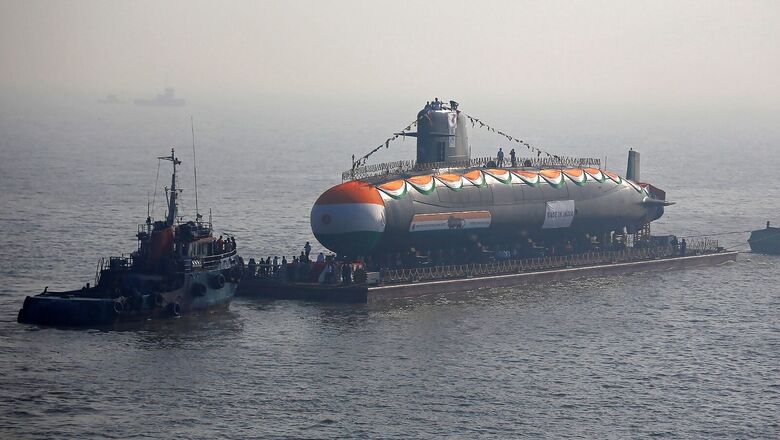
views
India has finally issued the Request For Proposal (RFP) for the acquisition of six submarines under Project 75I (P75I) to Mazgaon Docks Ltd. (MDL) and Larsen & Toubro (L&T), the two “strategic partners” chosen for the project. Now that’s the good news. The bad news is that the project is 20 years behind schedule. It will be at least another decade before the first of the submarines is in service—assuming all goes well from here on and the contract is signed by next year. That would be record-breaking! However, even if this were possible it will not stop the decline of submarine numbers nor would it likely be any more effective in acquiring submarine building skills than the current P75 programme. Given the terms of the strategic partnership model, there is possibility of the process getting delayed and derailed.
India should consider an indigenous project with the Indian Navy’s Submarine Design Group (SDG), DRDO, MDL, L&T, and other companies that have been involved in building the Scorpene and India’s nuclear submarines.
For some background, in 1981 India signed a contract with German company HDW for four of its Type 209 submarines with full technology transfer—two to be built in Germany and two in India. In 1985, two more were planned, but the kickback scandal led to their cancellation. However, the technology transfer was comprehensive. The Indian Navy’s (IN) SDG designed a submarine, based on Type 209 giving it the designation of Type 1500 under Project 75, but needed design validation which required foreign assistance. Letter of Intent was issued in 1997 to companies in France, UK, Sweden and Russia. It was only the French who were willing to participate in the project, provided their Combat Suite was selected for the submarines. Further, the Navy required tube-launched missiles. The French offered its SM-39 Exocet provided the French industry was chosen for the Combat System of Project-75 Submarine Project together with those to be modernized at a later stage. This was later given up for going with the French Scorpene, which was more advanced than the Type 1500.
However, the result of the decision was that India lost its chance to develop its own submarines and the expertise that MDL acquired in manufacturing submarines.
In 1999, a 30-year programme was approved to build 24 conventional submarines by 2030 by using two simultaneous programmes to build six submarines each under P75 and P75I via two separate production lines in phase 1. It was planned to acquire the 12 submarines by 2012. It was intended that phase 2 will be dedicated to building 12 indigenous submarines based on lessons learned from phase 1. The plan never came to fruition. Only the P75 saw light with the contract for six Scorpene submarines with Franco-Spanish consortium Armaris in 2005. After much delay, the first submarine was commissioned in 2017—five years behind schedule. The Indian Navy has since acquired two more. The remaining three will join the fleet by 2022-23.
The request for information (RFI) for P75I was first issued in 2008. In order to cut the familiar long story of defence procurement woes short, there were a number of reasons why the RFP was delayed, including the issue of which entity in India should build the submarines. In 2018, the government announced that this project would be given to MDL on a nomination basis, instead of the strategic partnership (SP) model that involved private shipbuilders before again reverting to it.
So what was to be a concurrent project to both shore up the submarine fleet and gain critical expertise to make submarines indigenously has become a “successor” project. By 2030, India would have produced only 6 submarines instead of the planned 24, and even this has been reduced to 18 due to budget constraints.
ALSO READ | AUKUS or Not, Why France is India’s Preferred Partner for Nuclear Attack Submarines
Potential for Delays and Derailment of P75I
It took 13 years from the initial RFI to the RFP. The two strategic partners (SPs) are free to engage with the five Original Equipment Manufacturers (OEMs), finalise one, and submit their techno-commercial offer. Although the Ministry of Defence (MoD) has selected the OEMs, it will be the SPs who will be making the final selection and will be solely responsible for the capabilities and willingness of the OEMs to meet obligations in accordance with the RFP.
Under the SP model, the winner will have to present a roadmap for future development, indigenisation content, an ecosystem of domestic manufacturers, partnerships with MSMEs, Defence PSUs, global supply chain which will be monitored by the MoD. The SP will also have to provide an R&D roadmap to achieve self-reliance. They, in turn, depend on the OEM to fulfil the requirements. In order to protect their interests and ensure compliance, the SP will have to bind OEMs to appropriate contracts. For such a major strategic project, the responsibility and liability have been left to the strategic partner.
There are apprehensions among foreign OEMs about the Strategic Partnership Model due to its complexity. SAAB pulled out in 2019 citing ‘unbalance’ in the SP Model. The nationalisation clause along with less than 50 per cent control could mean that OEMs will be less inclined to offer cutting-edge technology for the fear of losing intellectual property.
Moreover as seen from the CAG report on the MRCA (Multi-Role Combat Aircraft) tender, Dassault’s offer was non-compliant with the RFP to become L1 and the lengthy negotiations that followed wasted precious time and did not get the desired results and was ultimately scrapped. In the case of the P75I, OEMs are required to respond to SPs, who will submit their offers to the MoD. The chances of gaming to become L1 increase.
This could be problematic. It will hurt India’s objectives of acquiring the submarines in a timely manner and achieving the terms of RFP. The liability for non-compliance by the OEM will be on the SP. It is clear from the Rafale contract that even agreements at the intergovernmental level can be botched. While a public sector enterprise will be able to get away, it will be the death knell for a private entity.
India’s Current Submarine Building Capabilities
In the last 30 years, India has acquired technology for the Type 209, the Scorpene, and importantly, making its own nuclear-powered ballistic missile submarines and has an approved plan to make nuclear-powered attack submarines.
In an interview in 2012, Bernard Buisson, Managing Director of Naval Group India, said, MDL is “able to manufacture pressure hulls faster than we can do in our facilities in France”. According to him, “after successful manufacturing of the pressure hulls for the six submarines, MDL is now in the process of performing the very sophisticated tasks of outfitting: equipment, cables, pipes, cradles being integrated in each section hull. Soon all these tasks will be finalised, the learning curve will reach its plateau thus allowing MDL to be again the centre of excellence for submarine manufacturing in India. MDL is able to manufacture additional submarines as fast and efficiently as we could do in our facilities in France.”
Importantly, India’s nuclear submarine programme has helped build the expertise and supply chain in both the public and private sectors. INS Arihant’s hull was built by L&T’s Hazira shipbuilding facility which also did the detailed engineering using 3D modelling and product data management software. Tata Power SED built the control systems for the submarine. The steam turbines and associated systems integrated with the PWR (pressurised water reactor) were supplied by Walchandnagar Industries.
ALSO READ | Understanding the ‘Sub Text’: A Deep Dive into India’s Rs 43,000 Crore Project 75-I
Former Chief of Navy Admiral Arun Prakash in a piece in 2009 after the launch of Arihant, as the submarine is called after its commission into the Indian Navy, wrote: “a most significant and encouraging demonstration of India’s technological skills and managerial expertise. Indians being quick learners, our scientists, engineers and designers too, rapidly gained proficiency in many of the complex technologies involved in nuclear submarine construction.”
Listing the major gains from the project Admiral Prakash wrote, “A large number of private sector companies have not just participated but contributed most significantly to the project by mastering esoteric techniques and technologies, to design and fabricate major systems for the vessel and spawned a huge indigenization process in which small and medium ancillary industries all over the country have participated to contribute sub-systems and components manufactured to high precision and reliability specifications. DRDO and other defence laboratories have come up trumps in developing some excellent products like combat-management systems, sonars, and electronic warfare systems.”
The Indian government approved the construction of three nuclear-powered attack submarines this year, which are expected to be 95 per cent indigenous. The construction of these subs is anticipated to begin between 2023 and 2024. Additionally, the Indian shipyards are engaged in major refits and life extension of existing submarines.
A National Submarine Project
India currently has 15 conventional submarines. There are 4 Shishumar (HDW), 8 Sindhughosh (Kilo) and 3 Scorpene with 3 more to be inducted by 2022-23. Shishumars and Sindhughoshs are near the end of their service lives. Major refit and life certification of 2 Shishumar and 4 Sindhughosh-class submarines will extend their service lives by a decade, but this still leaves the Indian Navy with half the submarines it needs.
Given the nation’s current capability for building submarines, including nuclear-propelled submarines, it will be prudent to consider a similar national effort to make conventional submarines bringing in the SDG, MDL, L&T, DRDO and other major public and private companies and MSMEs that are working on India’s nuclear submarines project. India could take consultancy from friendly countries if it needs help in any areas. The Indian government can consider buying more Scorpene with air-independent propulsion (AIP) in the interim.
It was originally planned to install AIP on the last two Scorpene submarines and upgrade the first four when they came in for refit. This will keep the production line at MDL running after the sixth Scorpene is delivered in 2022-23. It will not only stem the falling numbers of the submarine force, but critically retain the expertise and skilled manpower, and not repeat mistakes from the past.
Yusuf Unjhawala is Editor, Indian Defence Forum. The views expressed in this article are those of the author and do not represent the stand of this publication.
Read all the Latest News , Breaking News and IPL 2022 Live Updates here.




















Comments
0 comment